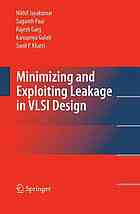

Most ebook files are in PDF format, so you can easily read them using various software such as Foxit Reader or directly on the Google Chrome browser.
Some ebook files are released by publishers in other formats such as .awz, .mobi, .epub, .fb2, etc. You may need to install specific software to read these formats on mobile/PC, such as Calibre.
Please read the tutorial at this link: https://ebookbell.com/faq
We offer FREE conversion to the popular formats you request; however, this may take some time. Therefore, right after payment, please email us, and we will try to provide the service as quickly as possible.
For some exceptional file formats or broken links (if any), please refrain from opening any disputes. Instead, email us first, and we will try to assist within a maximum of 6 hours.
EbookBell Team

4.7
46 reviewsMinimizing and Exploiting Leakage in VLSI Design
Nikhil Jayakumar, Suganth Paul, Rajesh Garg, Kanupriya Gulati and Sunil P. Khatri
Power consumption of VLSI (Very Large Scale Integrated) circuits has been growing at an alarmingly rapid rate. This increase in power consumption, coupled with the increasing demand for portable/hand-held electronics, has made power consumption a dominant concern in the design of VLSI circuits today. Traditionally, dynamic (switching) power has dominated the total power consumption of an IC. However, due to current scaling trends, leakage power has now become a major component of the total power consumption in VLSI circuits. Leakage power reduction is especially important in portable/hand-held electronics such as cell-phones and PDAs.
This book presents techniques aimed at reducing and exploiting leakage power in digital VLSI ICs. The first part of this book presents several approaches to reduce leakage in a circuit. The second part of this book shows readers how to turn the leakage problem into an opportunity, through the use of sub-threshold logic, with adaptive body bias to make the designs robust to variations. The third part of this book presents design and implementation details of a sub-threshold IC, using the ideas presented in the second part of this book.